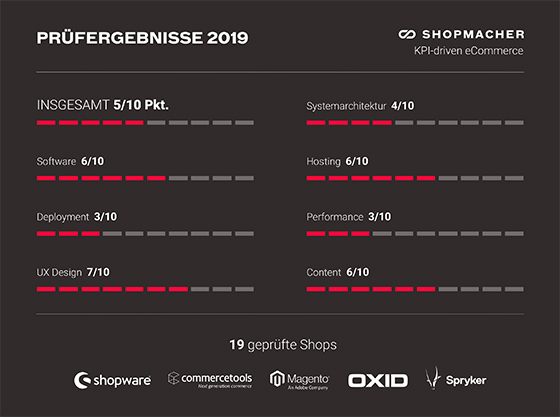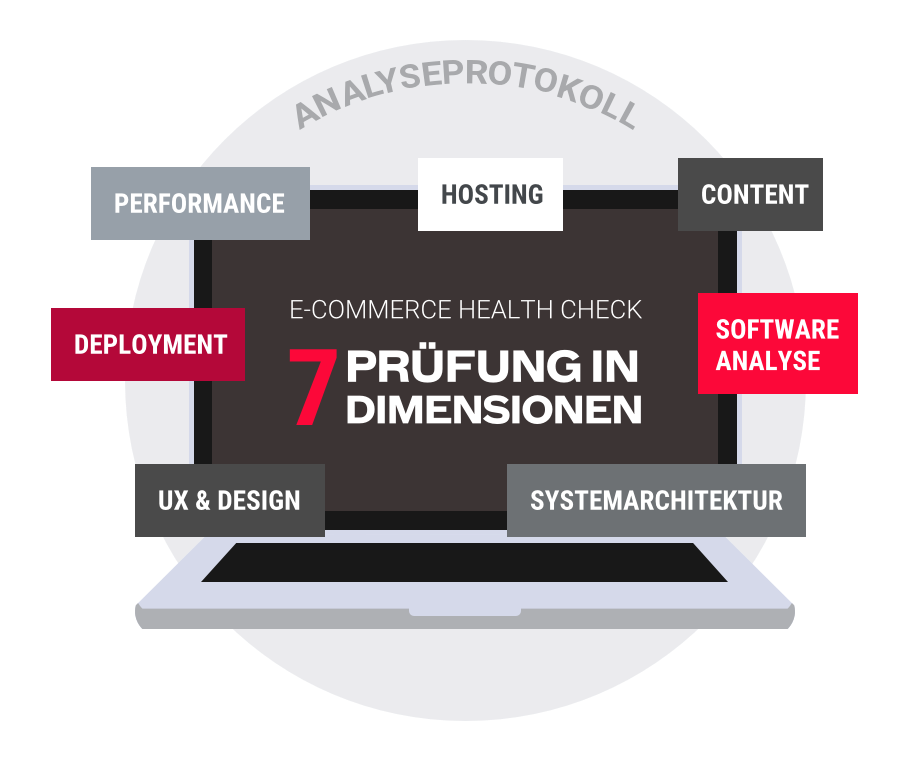FRONTEND HUI!, BACKEND PHOO!
The e-commerce test procedure of the SHOPMACHER from Gescher delivers remarkable results: under the hood, tested shops were not ideally positioned in 2019.
At the end of 2018, the SHOPMACHER developed the standardized health check procedure for e-commerce systems before taking over an external system. The “technical health” of an online shop is systematically put to the test in seven categories: system architecture, software, hosting, performance, deployment, UX/design, content.
In 2019, the Shopmacher carried out almost 20 health checks – for shops that were developed on the basis of the software solutions from Oxid, Shopware, commercetools, Spryker and Magento. Medium and large retailers and brands. B2B and B2C.
One thing is clear: every running setup has to contend with individual strengths and weaknesses, which usually arose historically and which can be countered with targeted interventions. And yet a remarkable pattern has emerged:
The shops tested generally achieved good results for UX, brand conformity and often also content. Many shop operators put their heart and soul into what the customer sees.
RECURRENT PROBLEM AREAS: PERFORMANCE, SECURITY, ARCHITECTURE/INTERFACES, DEPLOYMENT.
Also a typical problem area of almost all tested systems was the performance. Remarkable, because that has a direct impact on the conversion and should therefore actually be the focus of the shop operator. “It’s also there,” reveals Dütschke. “Most requests for the Health Check resulted from the sometimes urgent need to reduce loading times”.
RECURRENT PROBLEM AREAS: PERFORMANCE, SECURITY, ARCHITECTURE/INTERFACES, DEPLOYMENT.
nevertheless, because this is exactly where the SHOPMACHER testers had to start in order to achieve noticeable and sustainable improvements in the loading time.
It is also problematic in this context that the common Google tools, with which the performance is evaluated in order to objectify the “perceived loading time”, sometimes deliver contradictory results: Depending on which benchmark you set, you can evaluate performance according to different parameters and get completely different results. “Many traders are no smarter than their gut feeling after checking with standard tools,” reveals Tech Lead Patrick Blom, who examined some of the more complex systems.
In order to get neutral and reliable results here, the SHOPMACHER now use the CommerceScore tool developed by the partner ScaleCommerce, which specializes in e-commerce hosting. This relatively new analysis tool aims to generate consistent and valid test results without fluctuations in order to enable a perspective comparison of the results.
“In the course of our test, we have now come to a more reliable diagnosis and can also better identify the hidden performance killers,” reveals the SHOPMACHER.
The SHOPMACHER auditors were also surprised that almost all of the systems tested fell well below the required standard for enterprise e-commerce systems during the deployment process. “You don’t see it and it doesn’t have a direct impact on the sales figures. But an unprofessional approach to deployment entails considerable risks for a shop operator.” Here, the auditors found points of entry for hacker attacks, or the complete lack of the roll-back option, i.e. the possibility of restoring the shop to its previous state after a failed deployment. “You can bring down the whole shop with a deployment,” Blom warns.
In the end, the bottom line is that those responsible for the tested systems rightly attach great importance to the look and feel of their systems – apparently because the connection to the sales success of the shops is obvious, but often do not know or are aware of the risks of creeping technical neglect underestimate.
ALSO INTERESTING

Digitally accessible – or soon to be left out?
The countdown is on: On June 28, 2025, the Accessibility Reinforcement Act (BFSG) will come into force. But reality shows that many online stores are not yet ready. The new Accessibility Study 2025 reveals: The digital shopping world is still full of avoidable hurdles.

“Amazon is a role model when it comes to measuring and optimizing”
According to André Roitzsch, digital pioneer and CEO of SHOPMACHER, it no longer works to carry out a website relaunch and then sit back and relax for three years. ITD: Mr. Roitzsch, the Corona crisis and the associated temporary business closures have given...

Exclusive Shopmacher team at the office partners
For more than 20 years, the office partners from Gescher in Münsterland have developed into an internationally renowned player in the field of office technology. With around 130 employees, the office partners provide their customers with office technology: printers,...

